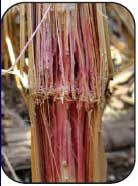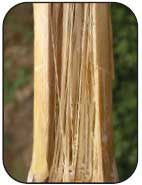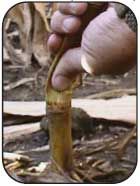Stalk rots cause damage and yield loss in many corn fields across North America each year. Depending on location, stalk rot organisms may include anthracnose, Gibberella, Diplodia or Fusarium, all of which survive in corn residue and are spread to the next crop by wind and/or rain. Stalk rots can reduce corn yield by killing the plant before physiological maturity. They can also cause plant lodging, increasing harvest losses and impeding harvest progress. If ears from a fallen plant come in contact with the ground for an extended period, grain quality may also be reduced. Each of these 4 diseases is briefly explained and shown below, to help growers identify them correctly. Identifying disease issues at harvest makes growers better prepared to select hybrids for the coming season.
Pioneer research teams have developed and characterized a wide lineup of products that are recognized by growers for their ability to help protect against stalk diseases. For more information on corn diseases and hybrid options to manage them, contact your local Pioneer sales professional.


HX1 - Contains the Herculex® I Insect Protection gene which provides protection against European corn borer, southwestern corn borer, black cutworm, fall armyworm, lesser corn stalk borer, southern corn stalk borer, and sugarcane borer; and suppresses corn earworm.
HXX - Herculex® XTRA contains both the Herculex I and Herculex RW genes.
Herculex® Insect Protection technology by Dow AgroSciences and Pioneer Hi-Bred. Herculex® and the HX logo are registered trademarks of Dow AgroSciences LLC.
All hybrids with Herculex® traits also contain the LibertyLink® gene.

Liberty®, LibertyLink and the Water Droplet design are trademarks of Bayer.
Pioneer® brand products are provided subject to the terms and conditions of purchase which are part of the labeling and purchase documents. Pioneer is a brand name; numbers identify products.




